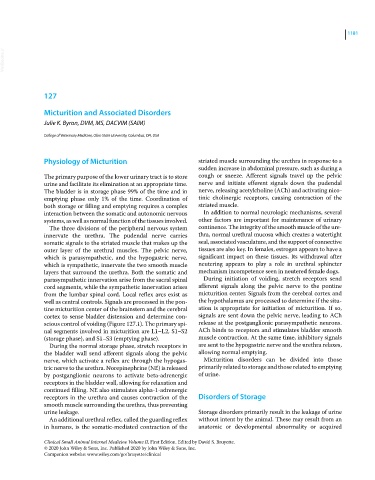Page 1243 - Clinical Small Animal Internal Medicine
P. 1243
1181
VetBooks.ir
127
Micturition and Associated Disorders
Julie K. Byron, DVM, MS, DACVIM (SAIM)
College of Veterinary Medicine, Ohio State University, Columbus, OH, USA
Physiology of Micturition striated muscle surrounding the urethra in response to a
sudden increase in abdominal pressure, such as during a
The primary purpose of the lower urinary tract is to store cough or sneeze. Afferent signals travel up the pelvic
urine and facilitate its elimination at an appropriate time. nerve and initiate efferent signals down the pudendal
The bladder is in storage phase 99% of the time and in nerve, releasing acetylcholine (ACh) and activating nico
emptying phase only 1% of the time. Coordination of tinic cholinergic receptors, causing contraction of the
both storage or filling and emptying requires a complex striated muscle.
interaction between the somatic and autonomic nervous In addition to normal neurologic mechanisms, several
systems, as well as normal function of the tissues involved. other factors are important for maintenance of urinary
The three divisions of the peripheral nervous system continence. The integrity of the smooth muscle of the ure
innervate the urethra. The pudendal nerve carries thra, normal urethral mucosa which creates a watertight
somatic signals to the striated muscle that makes up the seal, associated vasculature, and the support of connective
outer layer of the urethral muscles. The pelvic nerve, tissues are also key. In females, estrogen appears to have a
which is parasympathetic, and the hypogastric nerve, significant impact on these tissues. Its withdrawal after
which is sympathetic, innervate the two smooth muscle neutering appears to play a role in urethral sphincter
layers that surround the urethra. Both the somatic and mechanism incompetence seen in neutered female dogs.
parasympathetic innervation arise from the sacral spinal During initiation of voiding, stretch receptors send
cord segments, while the sympathetic innervation arises afferent signals along the pelvic nerve to the pontine
from the lumbar spinal cord. Local reflex arcs exist as micturition center. Signals from the cerebral cortex and
well as central controls. Signals are processed in the pon the hypothalamus are processed to determine if the situ
tine micturition center of the brainstem and the cerebral ation is appropriate for initiation of micturition. If so,
cortex to sense bladder distension and determine con signals are sent down the pelvic nerve, leading to ACh
scious control of voiding (Figure 127.1). The primary spi release at the postganglionic parasympathetic neurons.
nal segments involved in micturition are L1–L2, S1–S2 ACh binds to receptors and stimulates bladder smooth
(storage phase), and S1–S3 (emptying phase). muscle contraction. At the same time, inhibitory signals
During the normal storage phase, stretch receptors in are sent to the hypogastric nerve and the urethra relaxes,
the bladder wall send afferent signals along the pelvic allowing normal emptying.
nerve, which activate a reflex arc through the hypogas Micturition disorders can be divided into those
tric nerve to the urethra. Norepinephrine (NE) is released primarily related to storage and those related to emptying
by postganglionic neurons to activate beta‐adrenergic of urine.
receptors in the bladder wall, allowing for relaxation and
continued filling. NE also stimulates alpha‐1‐adrenergic
receptors in the urethra and causes contraction of the Disorders of Storage
smooth muscle surrounding the urethra, thus preventing
urine leakage. Storage disorders primarily result in the leakage of urine
An additional urethral reflex, called the guarding reflex without intent by the animal. These may result from an
in humans, is the somatic‐mediated contraction of the anatomic or developmental abnormality or acquired
Clinical Small Animal Internal Medicine Volume II, First Edition. Edited by David S. Bruyette.
© 2020 John Wiley & Sons, Inc. Published 2020 by John Wiley & Sons, Inc.
Companion website: www.wiley.com/go/bruyette/clinical

